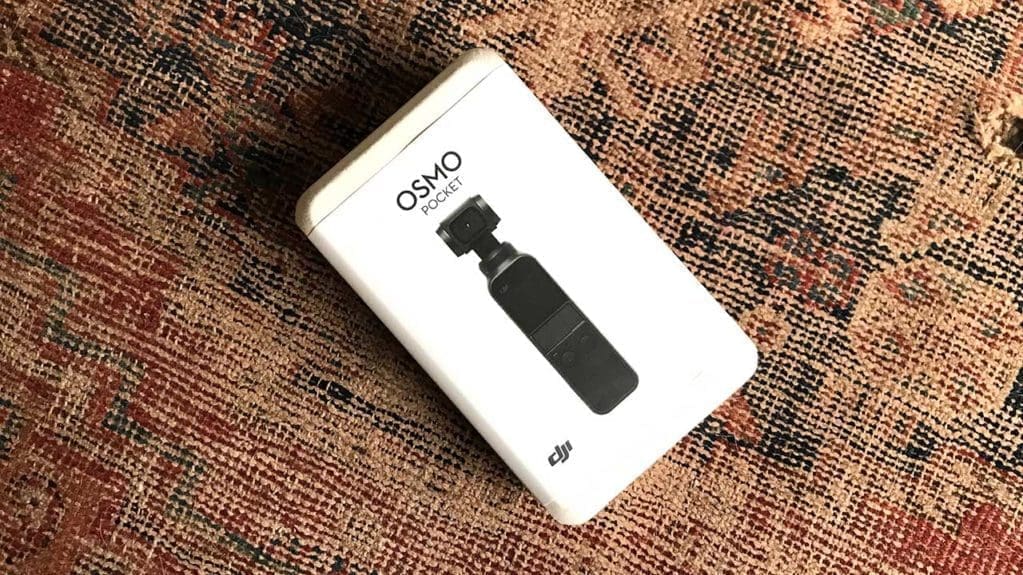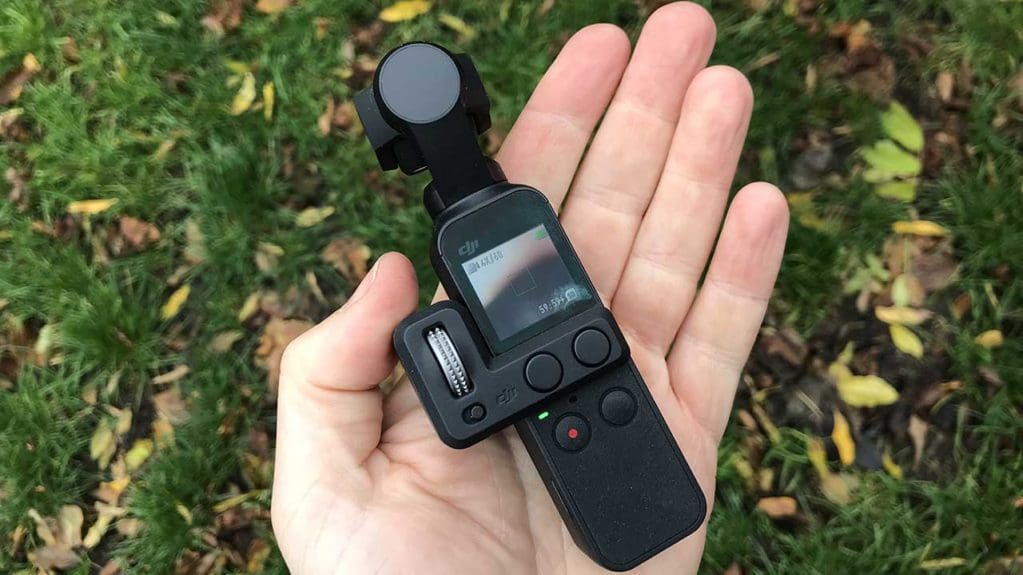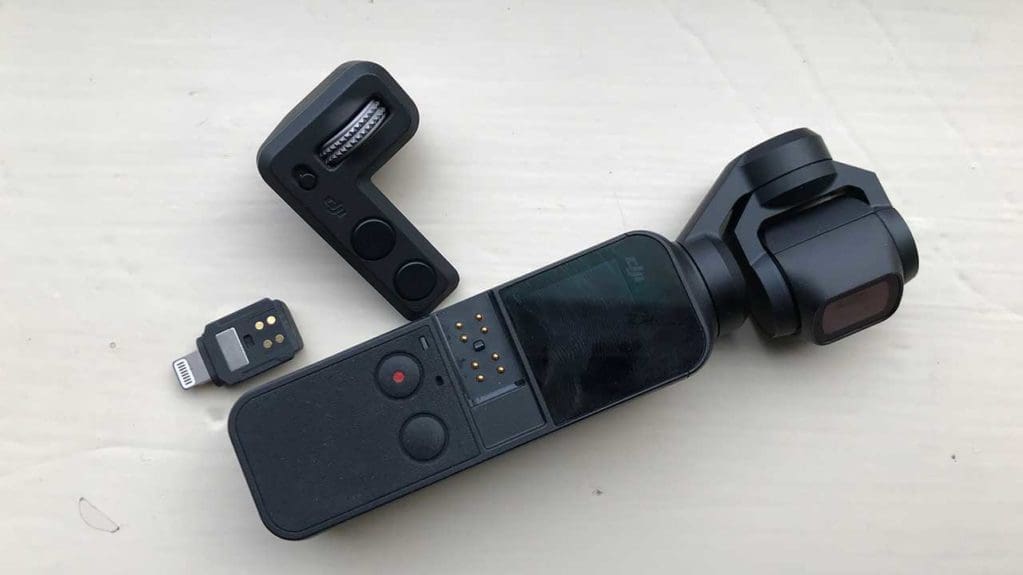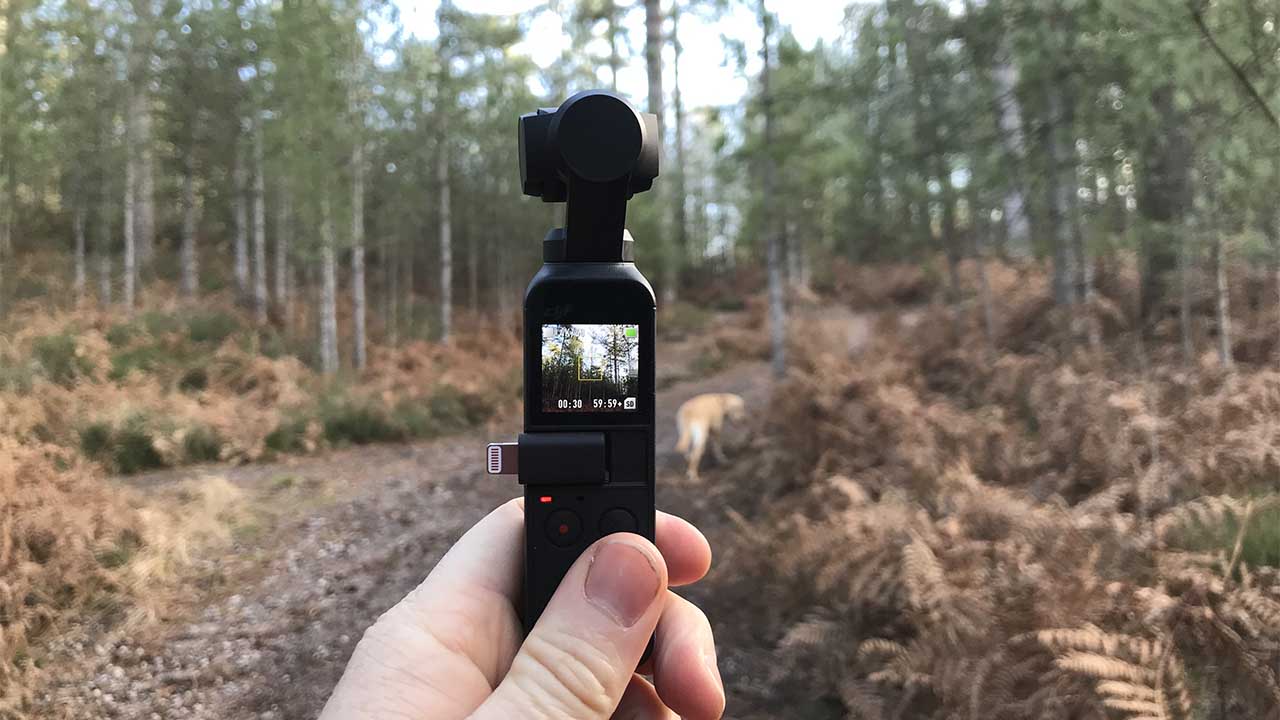If you haven’t come across the DJI Osmo range before then it’s a stabiliser system from the drone innovators DJI. The latest addition to the Osmo range is the DJI Osmo Pocket, the smallest, lightest and most impressive Osmo to date.
There are already several Osmo models on the market, catering for the Professional user all the way through to those just wanting a mechanical stabiliser for their mobile phones.
First Impressions
The Osmo range is far more than just the image stabilisation as the featured app enhances the abilities and control of either the built-in or mobile cameras. The Osmo series has enabled anyone access to pro-level filmmaking on a budget. What’s more, the scale of the Osmo range has always been compact, but now all those seemingly small past Osmo models look positively bulky with the arrival of the DJI Osmo Pocket.
Check out the packaging… Yes, that’s fully recyclable, cardboard I think, but could be some other sustainable material. In the past only Olfi has impressed me this much with their packaging offering.

I knew the Osmo Pocket was going to be small, but nothing had quite prepared me for how small!
It weighs just 116g, that’s the weight of two standard sized Mars bars. Yet in dimensions, it’s the size of one… or is it? I better buy a few and find out.
Check out the size of the DJI Osmo Pocket compared with my hand… Small!

Being small you’d think that DJI may have had to pull back on the features, but alongside the 3-axis mechanical image stabilisation you have 4K at 60fps, a series of intelligent shooting modes and many Instagram generation friendly effects.
Initial impressions of the build are excellent. It’s a compact and robust device, there’s nothing flimsy about the design. That said, the module connectors such as the USB or Lightning adapter and the control wheel are a little awkward.

Powering up and all seems straightforward. A red button to record and press again to stop. The Osmo seems to self-calibrate at lightning speed. The small LCD screen acts as a good preview to what’s being filmed and the fact that its touchscreen enables you to quickly switch modes and review footage. At present, I’m not sure if you can adjust the resolution but most other options seem to be directly accessible.
Slide in the Lightning adapter and plug into a mobile phone and the device transforms. The new DJI Mimo app enables a familiar Osmo experience and starts to really reveal the power of this small device. I’ll continue to explore and bring you more on that soon.
DJI’s experience in quality image and stabilisation shine through. Although the Osmo Pocket has just arrived initial impressions of the video capture are good, although, with no external mic input, audio is limited to that recorded on board.
I didn’t expect a camera, stabiliser combo of this size to be so good from the outset. I’ve already found a few things that feel like there’s room for improvement but for the price and in comparison with anything else available, it’s streets ahead.
DJI Osmo Pocket review Introduction
The DJI Osmo pocket is an image stabiliser and camera in one. It is in effect the Osmo but on a much smaller scale, and by smaller I mean a small.
Packed into the small frame, which is smaller than my hand are an unbelievable amount of features, and the smart modular design that enables extras to be added is an inspired move, I’ll delve into those in-depth later.
The small size makes it different from anything else on the market, yet the size and ergonomic design aren’t so small it’s unusable, it’s a delicate balance which has just been met by the DJI design teams.
But, why this over your mobile? The size makes it acceptable to carry around, but the motion features, video effects, direct connection into any mobile device, recording time and outright quality put this streets ahead of the iPhone XR and Huawei P20 when it comes to video capture.
Features
At £329 the Osmo pocket has been priced aggressively and is aimed at today’s growing YouTube and Instagram generation.
However, if you’re a relatively normal individual and want a decent video camera to have some fun with the family or friends, the Osmo Pocket should also definitely be considered.
Let’s run through a few of the key features; Mechanical image stabilisation, small size just 121.9 x 36.9x 28.6mm and weighs in at 116g.
Inside is a 1/2.3-inch CMOS sensor, 12mp effective which is fronted by a f/2.0 lens with an 80º FOV. ISO range is between 100-3200 for both video and stills.
It features an electronic shutter with a range of between 8s – 1/8000s. Still, photo modes include Single Shot, Panorama, Timelapse, Motionlapse.
Osmo pocket resolutions and framerates
- 4K Ultra HD: 3840 x 2160 24/25/30/48/50/60p
- FHD: 1920 x 1080 24/25/30/48/50/60/120p
Movies are captured in MP4/Mov and still JPEG, DNG or both. Files are stored on a MicroSD up to 256GB.
The 875mAh battery supplies the Pocket with 140 minutes of power and takes 73 minutes to charge. As well as the primary device there are a series of modules; these include the mobile adapter (included), control wheel and Bluetooth, both optional.
The feature list is impressive, and the connection through to the Mimo App greatly extends the functionality. When it comes to feature, it’s both surprising how much is crammed in and also how apparent some of the technical challenges that faced DJI have been overcome.
What is evident is that there is no other device on the market that offers so many features in such as small package.
I’ll bring you more on the DJI Osmo Pocket in the coming days, for now, if you have any question or comments then please leave them in the box below.
Build & Handling
For the relatively small price tag of £329, you get an awful lot of camera and gimbal, not physically but feature wise.
Set up couldn’t be easier, this is no Ronin, just pop in a MicroSD card, up to 256GB, power on and you’re ready to start the capture.
Finding your way around the settings and options using the small LCD screen can be a little tricky due to its small size. But, with a little concentration and patience it perfectly workable and probably the best solution for such a small size.
In fact, I can’t think of a better way to give the user direct control over the settings considering the size unless the entire body of the Osmo was covered in buttons and dials.
Once switched on and in use with no other accessories, there’s little to the camera and gimbal combo. Everything is pretty much handled for you when it comes to filming so you can get on with whatever it is you’re doing.
The small preview screen works exceptionally well despite it’s the size and after a very short time, you get used to it.
As the screen is touch screen you do get a few controls that you can operate directly such as the tilt. This works by touching your finger on the right of the screen and then on the left you’ll see a bar flash. You can then move your finger up and down to tilt the angle of the camera.
As far as I could see there’s no way to rotate the gimbal head using the screen, but then that’s not really an issue.
Delving into the menu and there are three options for the way that the gimbal can be used; follow, tilt lock and FPV. For the most part in this test, I kept to the following option.
The setting for the camera are equally easy to navigate, and after a little time with the interface, you can find access to all common features including the ability to change resolutions and frame rates independently.
After a short time, you realise that although convenient in the compact form a little more smooth interaction with the Osmo Pocket would be good.
The first accessory to fit is the jog wheel and this just slots into the accessories port on the front. Once attached the accessory is instantly recognised and usable.
The jog wheel has two additional buttons and the wheel, and this enables tilt and rotation of the gimbal head. You can switch between tilt and rotate by using the small switch under the jog wheel.
For absolute control over the Osmo Pocket, you need to connect in the phone adapter. This again plugs into the accessories port on the front. To fit through the jog wheel accessory needs to be removed.
Once the lighting adapter has been attached then an iPhone can be plugged in.
There is a Bluetooth adapter as there is no Bluetooth built in but this appears to be a base rather than a portable accessory. I have yet to see one so will need to comment on that in the future.
In order for the iPhone to communicate with the Osmo Pocket, the Mimo app needs to be downloaded. With the app installed as soon as you plug the Pocket into the phone, the app appears ready for use.
The first time you log in you need to login to your DJI account and register the device. If you have an account already then this just takes a few moments.
Mimo is like other DJI Apps I’ve seen in the past, clear and concise with all controls and options clearly laid out.
Navigating around the screen is easy enough and locating all the resolution and frame rate features are all apparent.
Within the app, you have all the controls that you would expect to see along with a few nifty effects that you can apply to your videos.
These effects are easy enough to use, select the theme you want and then the Osmo Pocket will show four-time slots, hit record and the music for that theme will play and the Osmo will rotate and move to create the effect.
Each of the time slots lasts for a couple of seconds and between each, you have to manually select when the next clip will start. Once the clips are complete the Osmo Pocket stitches them together into one piece ready for saving locally or uploading to your social network of choice.
The effects are impressive and great fun, but when it comes to saving through the app the journey at the moment is not smooth.
Once you select to save, the app then takes you to the share options but doesn’t give you any obvious way to return to the main screen.
When you do click back the app warns you that the clip will be lost, but actually, it won’t be as it is saved locally.
Not as smooth as it should be, but then this is early days for the device and app and is something that will inevitably be sorted out soon.
The app also gives you full control over the gimbal with a touchscreen joypad that enables you to rotate and tilt the camera. This works exceptionally well and makes for powerful use.
Alongside, the video options and effects are a few for stills. I was particularly interested in the panoramic having used the Ronin-S to similar effect over the summer.
The Pano mode enables you to activate and then leave the Osmo Pocket to take the shot automatically with the head rotating through the motions. It’s an impressive feature and one that I can see working in all sorts of situations to great effect.
The panorama mode really highlights the intended use of the Osmo Pocket, it’s a personal device that should be held and not settled down. So don’t expect an automated gimbal rig which can be controlled remotely, that’s not what the Osmo Pocket is about, at this time.
Let me explain. The Panoramic mode enables you to take a panoramic while the Pocket is being held, so a vista in front of you, or you and your mates with a backdrop of stunning scenery.
Although you can settle the Pocket down on a flat surface and take the same shot, it just doesn’t physically lend itself to doing so. It has a flat base so this is possible, but it doesn’t have a 1/4-inch thread on the base for a compact tripod.
Likewise, if you’re holding the thing then you just tap a button and all easy, if you put it down you need to hold it to set it going as there is no Bluetooth connection as standard to connect to the app.
If you have the phone connected then the pocket will just fall over if you try to leave it standing on its own.
The Osmo Pocket should be held.
Overall the build and handling of the pocket is excellent, used in isolation it’s convenient, and I really liked the jog wheel although a full joystick would have been nice.
However, to access all the controls you do need to plug in the Pocket into a smartphone. Once connected the options are endless but that connection through either a Lightning or USB feels somewhat flimsy.
There were a few occasions where after a time I was unsure of what part of the phone I should be holding for the best support, in the end, opted for both for fear of one or other of them dropping off.
Ok, I was being a little over cautious as the Osmo is a review sample and my phone is one drop away from being replaced, but still, I felt some lightweight cradle or support clip would have been a good idea.
If I was to buy one, I’d definitely have to create a 3D print a clip to keep the whole thing tight and rigid.
Saying that it’s not as if the connection is loose and holding either the phone or Pocket, it doesn’t feel like the other isn’t supported. It’s just it doesn’t feel as secure as you think it should be.
Read our Guide to the Best DJI Osmo Pocket Accessories
Performance
The compact Osmo Pocket is the perfect travel companion, small, lightweight and dead easy to use.
When it comes to video quality the image looks fantastic, clear, crisp and well saturated. Obviously, for this size of the device, the amount of creative control over the image quality isn’t huge, but there’s enough to have plenty of fun.
Then you have the creative modes which are great for capturing a quick clip to share on those social platforms.
When it comes to video quality there is little to fault at 4K or 1080p, it’s as good quality as any action camera out there, with high levels of detail and smooth fluid motion.
The addition of the motorised gimbal adds to the professional effect of the video capture, there’s no doubt that the Osmo Pocket has huge potential.
But the more you use it the more minor niggles you start to notice. Niggles? Maybe thoughts of features that you wish it had.
That missing feature list is small but significant:
Features the Osmo Pocket doesn’t have, that I feel it should
- Live Streaming to any platform
- Bluetooth built-in
- Log mode for video capture
- A lanyard attachment (the supplied one attaches to the case)
The list is probably longer, but for now, those are the main issues. Here’s why.
Live Streaming is a huge part of everything at the moment, even GoPro has finally added the feature to the Hero7 Black.
The Osmo Pocket is the ideal vlogger/blogger camera, it’s small lightweight and, well as near as damn it perfect for that audience, except it doesn’t live stream. How can you live in the moment if you have to edit the footage and upload it later?
However, as most of DJI’s products already feature live streaming I’d be very surprised if this wasn’t released as an update very soon.
Since I started looking at the Osmo Pocket updates have arrived that have expanded its features and usability, so why not live stream.
Live Streaming is one thing, but if you’re going to use this to become the next YouTube sensation you need great sound, but there’s no mic input.
To be honest the sound is good, except when you put your finger over the mic, but nevertheless, an external mic is important.
As there’s a USB-C port in the base, again with an update this may well be possible. For now, I’ve tried the GoPro Mic Adapter and a couple of other options but no luck.
BlueTooth is available with an adapter that plugs into the base, this is just another accessory that you need to take with you. The size of the Osmo Pocket is great but I would have said that a small increase in size would have been worth the inclusion of BlueTooth built in.
Finally log modes, this may be pushing the boundaries of what’s really needed in a device of this size, but I think it has the potential to be a great movie-making tool.
On that note, if it was able to utilise Filmic Pro the possibilities would be endless.
OK, there are things that the Osmo Pocket doesn’t have that you really think it should, but then the size and price could be the limiting factors. Maybe an Osmo Pocket Pro in the same way as the original Osmo appeared in a variety of models.
However, you look at it the Osmo Pocket is held back by its potential. When it comes to performance the video and audio quality really cannot be beaten for this size of the device.
But, because it has so much potential you expect more; live stream video, external mic, log modes and connection to pro level apps.
Verdict
The Osmo Pocket is in many ways groundbreaking, but at the same time, it isn’t. Feature-wise we’ve seen it all before, a small mechanically stabilised grip that enables you to shoot pro looking footage easily and with minimal equipment. What we haven’t seen before are these features this small and for this price and that makes it infinitely more exciting.
The compact size and weight mean that it can truly be carted around with you at all times. Meanwhile, the interaction and control with the app enable you to take high res images of the type that you just can’t with other cameras of this size. Being able to control the gimbal through the phone to capture motion time-lapses is also a stunning feature and again far smaller than any other time-lapse enabled rig on the market.
When used as a video camera, the stabilisation is excellent. Personally, I think the video quality is superb as is the audio for a device of this size. The fact that the design is modular, enabling you to add extras such as the jog wheel, phone adapter or plug in an external mic also boosts the abilities of this small device further.
I like the Osmo Pocket, I think it’s a fantastic device, but would I buy one? Not at the moment, although that could change with an update. You see, while the Osmo Pocket was a lot of fun during the test it didn’t live stream. I can film and upload but I can’t film and stream, and for me that would be the point of the Osmo Pocket. But, then I’ve shown the device to friends and they love it, the way that it’s small and fits in a pocket. The way you can take short clips and it matches them with music ready to upload, it’s like the big VHS cameras of the 80’s for the present day. It has its charms but for me, there needs to be more.
At present, the DJI Osmo Pocket feels about 80% complete. The hardware is in place but the app and control need a bit of a boost. Add live streaming and auto-editing feature and then we’ve got a product, one that no vlogger, blogger or self-respecting social media star should be without. Otherwise, it’s just a small camera on a stick, albeit a very good and small one that everyone I’ve shown has loved.



